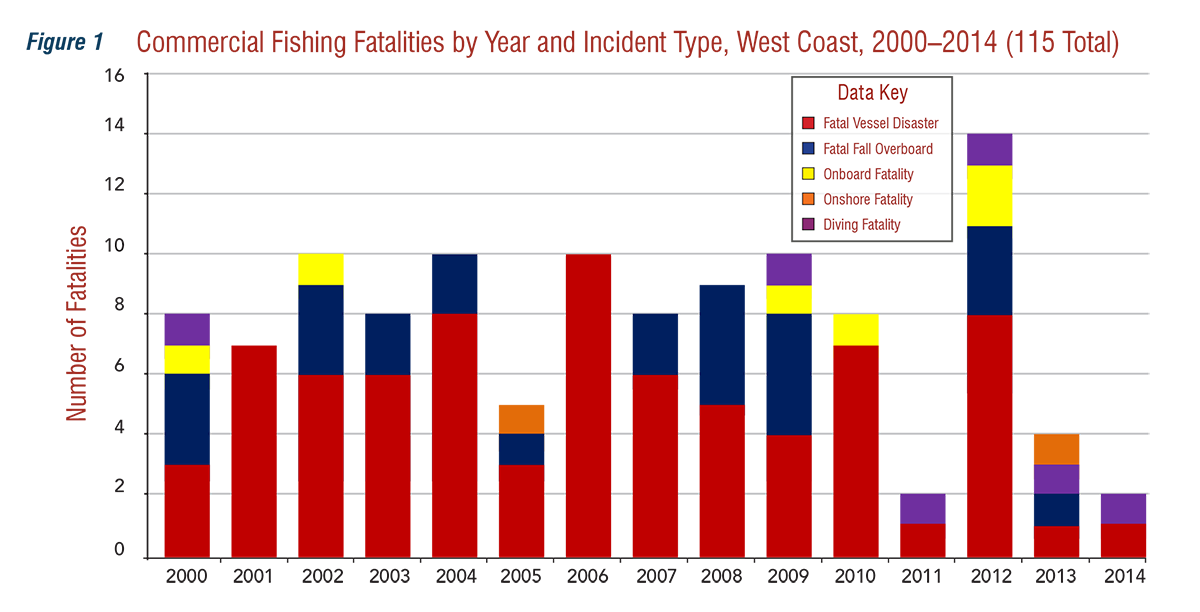COMMERCIAL FISHING SAFETY
Commercial Fishing Safety on the West Coast

During the 15-year period 2000–2014, 115 deaths due to traumatic injury occurred in West Coast fisheries, averaging almost eight fatalities annually (Figure 1). During the first decade (2000–2009), 85 fatalities occurred, for an average of nearly nine deaths per year. For the most recent five-year period (2010–2014), 30 commercial fishing fatalities were recorded, averaging six fatalities annually. This recent period experienced both the lowest (two deaths) and the highest (14 deaths) numbers of annual fatalities that occurred during the entire 15-year period.

West Coast Leading Hazards and Recommendations
Vessel Disasters
Vessel disasters are sinkings, capsizings, groundings, fires, or other events that force crews to abandon ship. Vessel disasters were a leading cause of commercial fishing fatalities during 2010–2014, contributing to 60% of all fatalities for the West Coast. Four fatal vessel disasters, which resulted in eight crewmember deaths, contributed to the highest number of fatalities during 2012. The most frequent causes of fatal vessel disasters included striking rocks, flooding, and being struck by large waves.
Recommendations:
- Take a marine safety class at least every five years.
- Conduct monthly drills for abandon ship, fire, and flooding.
- Ensure watertight integrity of the vessel.
- Maintain proper watch.
Falls Overboard
Compared to the preceding 10-year period (2000–2009) during which there were 21 fatal falls overboard, this recent five-year period has shown a decrease in the number of fatal falls overboard. During 2010–2014, four crewmembers died from drowning after falling overboard, contributing to 13% of fatalities in the region. None of the fishermen were wearing a personal flotation device (PFD) when they drowned. Two falls overboard involved fishing gear: one fisherman was entangled in gear and another was knocked overboard by gear. The third incident involved a fisherman losing his balance and falling overboard. A fourth incident’s cause was unknown.
Recommendations:
- Wear a PFD on deck.
- Use a man-overboard alarm system.
- Add effective recovery devices and re-boarding ladders.
- Conduct man-overboard drills monthly.
Diving Fatalities
Diving incidents 2010-2014 also resulted in four deaths (13%). Of the four diving-related fatalities, two involved rapid ascent and two involved gear entanglement.
Recommendations:
- Dive with an experienced, alert tender.
- Be prepared for a diving emergency.
- Maintain diving equipment.
West Coast Fishing Fatalities by Fleet

Fatalities occurred in 12 fleets along the West Coast during 2010–2014, with seven fleets experiencing two or more fatalities (Figure 2).
Dungeness Crab
The Dungeness crab fishery experienced the highest number of fatalities in the region, with eight crewmember deaths. In the non-tribal Dungeness crab fleet, four fatalities occurred during separate vessel disasters and one fatality as the result of a fall overboard. In the tribal Dungeness crab fleet, two fatalities were due to falls overboard and one to a vessel disaster. NIOSH recommends wearing a PFD on deck at all times.
Want to know more?
For more statistical information and detailed recommendations on how to keep you and your fellow crewmembers safe, open or download the full regional summary: Commercial Fishing Fatality Summary, West Coast Region (2010-2014)
For more information about other regions, visit our Alaska, Gulf of Mexico, and East Coast regional summary pages.
- Page last reviewed: July 25, 2017
- Page last updated: July 25, 2017
- Content source:
- National Institute for Occupational Safety and Health Office of the Director


 ShareCompartir
ShareCompartir